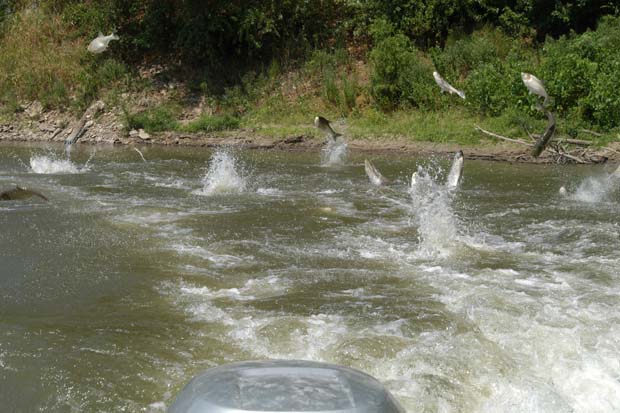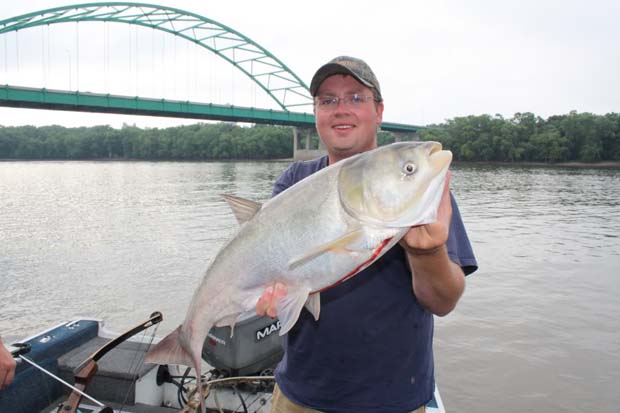Fish Out of Water

Carp react flight or fight at almost any noise and can go airborne over 10-feet in the air.
Photo Missouri.edu
[dropcap]I[/dropcap]t’s impossible to fish peacefully on the Illinois River anymore. One minute, you’re floating downstream, casting your line quietly on the surface of the water. Then, without warning, dozens of fish start flying frantically through the air—40-pound torpedoes colliding with anything and anyone in their path.
It’s the stuff of a 1950s horror film, but it’s a reality in this waterway dominated by invasive Asian carp. As those carp push north, they’re threatening every national park unit connected to the Mississippi River—and the multi-billion-dollar tourism industry linked to it.
Like many invasive species, the carp were introduced with good intentions. In the 1970s, fish farmers imported silver, bighead, grass, and black carp—extremely efficient bottom feeders from Asia—to help keep catfish farms clean. Heavy rains caused flooding, and the fish escaped into nearby waterways.
In 2011, John Anfinson, chief of resource management for the Mississippi National River and Recreation Area, learned that silver carp and bighead carp were making a dramatic advance up the Mississippi River and sounded the alarm with key federal and state agencies. The species out-compete native fish for food and resources, which could devastate the Mississippi’s ecosystem. And then there’s the danger of startling hundreds of silver carp, whose flight-or-fight response is to leap as high as 10 feet into the air (an event that’s sent Illinois River boaters to the hospital with broken jaws and concussions).
“We put 11,000 middle-school students in canoes on the river last year,” Anfinson says. “If silver carp start jumping out of the water and tip a canoe or hurt these kids, it could end our program. We’re working so hard to get people to the river, but this would scare people away from it.”
Scientists are searching for ways to keep the invasion from escalating. Among the options: deterrents that employ bubbles, sound, and light in an attempt to keep carp from swimming upstream.
“If there’s a jackhammer on the sidewalk making lots of noise, you might walk to the other side of the street to avoid it,” Anfinson says. These deterrents would work in much the same way, and could be especially effective considering Asian carp have a great sense of hearing, much better than native fish. Add flashes of light and a curtain of bubbles, and carp might just swim away.

Get hit with on of these going 25MPH and you’re in the hospital – if you’re lucky.
Photo Michigan Sportsman
Scientists are also working to isolate the pheromone to lure carp and create a “carpicide” to poison them—a technique that’s worked well to control invasive lamprey populations in the Great Lakes.
But states might be years away from successfully implementing these ideas, if the ideas even work at all. So for now, the Stop Carp Coalition—a diverse group of anglers, private property owners, and conservation groups like NPCA— is advocating for lock closures where they make the most sense, in the hope of slowing the spread of Asian carp. “It’s been a hard pill to swallow for some of our decisionmakers,” says Christine Goepfert, NPCA’s Upper Midwest program manager and the coalition’s co-leader. “Two barging companies upstream are still using these locks, so it may be more practical to help them find alternative shipping methods or subsidize the costs of relocating their businesses rather than pay for expensive and unproven deterrents.” The coalition is also working with Congress to pass legislation that would require lock closures in certain areas.
“Republicans and Democrats at all levels of government want to do something about this,” Goepfert says. “That makes me hopeful that we’ll see some much-needed action soon.”
[information]
By Amy Marquis, National Parks Magazine Associate Editor
National Parks Conservation Association
777 6th St NW #700 Washington, DC 20001
(800) 628-7275
[/information]





